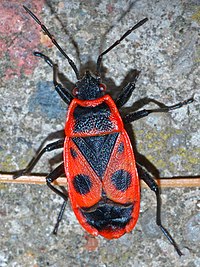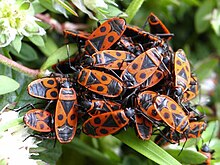Megha
New member
[lang=en]


 [FOOTNOTE]Images : wikimedia.org[/FOOTNOTE]
[FOOTNOTE]Images : wikimedia.org[/FOOTNOTE]
The firebug, Pyrrhocoris apterus, is a common insect of the family Pyrrhocoridae. Easily recognizable due to its striking red and black colouration, it is distributed throughout the Palaearctic from the Atlantic coast of Europe to northwest China. It has also been reported from the USA, Central America and India[1] It has been reported as recently expanding its distribution northwards into mainland UK. They are frequently observed to form aggregations, especially as immature forms, with from tens to perhaps a hundred individuals.
Reproduction
Firebugs generally mate in April and May. Their diet consists primarily of seeds from lime trees and mallows. They can often be found in groups near the base of lime tree trunks, on the sunny side.
They can be seen in tandem formation when mating which can take from 12 hours up to 7 days. The long period of copulating is probably used by the males as a form of ejaculate-guarding under high competition with other males.
Development
P. apterus was the subject of an unexpected discovery in the 1960s when researchers who had for ten years been rearing the bugs in Prague, Czechoslovakia attempted to do the same at Harvard University in the United States. After the 5th larval instar, instead of developing into adults, the bugs either entered a 6th instar stage, or became adults with larval characteristics. All specimens died without reaching maturity.
The source of the problem was eventually proven to be the paper towels used in the rearing process. Furthermore, the researchers were able to replicate these results with American newspapers such as the New York Times, but not European ones like The Times. The specific cause was discovered to be hormones found in the native balsam fir tree (Abies balsamea) used to manufacture paper and related products in America. This hormone happened to have a profound effect on P. apterus, but not on other insect species, showing the diversification of hormone receptors in the insects. [FOOTNOTE]wikipedia.org[/FOOTNOTE][/lang]
[h=1]Reference & Resources[/h]
[REFLIST]1[/REFLIST]



The firebug, Pyrrhocoris apterus, is a common insect of the family Pyrrhocoridae. Easily recognizable due to its striking red and black colouration, it is distributed throughout the Palaearctic from the Atlantic coast of Europe to northwest China. It has also been reported from the USA, Central America and India[1] It has been reported as recently expanding its distribution northwards into mainland UK. They are frequently observed to form aggregations, especially as immature forms, with from tens to perhaps a hundred individuals.
Reproduction
Firebugs generally mate in April and May. Their diet consists primarily of seeds from lime trees and mallows. They can often be found in groups near the base of lime tree trunks, on the sunny side.
They can be seen in tandem formation when mating which can take from 12 hours up to 7 days. The long period of copulating is probably used by the males as a form of ejaculate-guarding under high competition with other males.
Development
P. apterus was the subject of an unexpected discovery in the 1960s when researchers who had for ten years been rearing the bugs in Prague, Czechoslovakia attempted to do the same at Harvard University in the United States. After the 5th larval instar, instead of developing into adults, the bugs either entered a 6th instar stage, or became adults with larval characteristics. All specimens died without reaching maturity.
The source of the problem was eventually proven to be the paper towels used in the rearing process. Furthermore, the researchers were able to replicate these results with American newspapers such as the New York Times, but not European ones like The Times. The specific cause was discovered to be hormones found in the native balsam fir tree (Abies balsamea) used to manufacture paper and related products in America. This hormone happened to have a profound effect on P. apterus, but not on other insect species, showing the diversification of hormone receptors in the insects. [FOOTNOTE]wikipedia.org[/FOOTNOTE][/lang]
[h=1]Reference & Resources[/h]
[REFLIST]1[/REFLIST]

